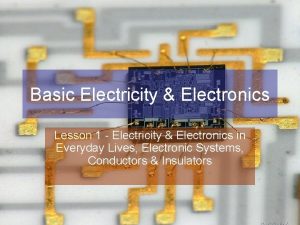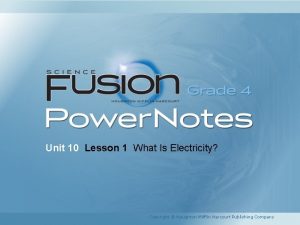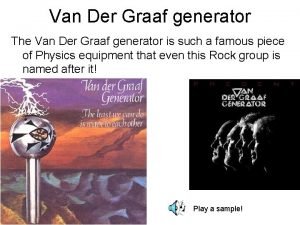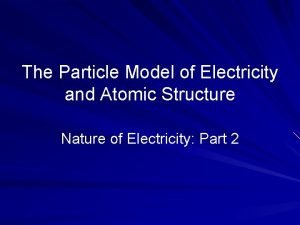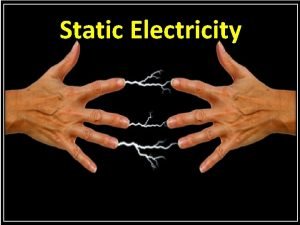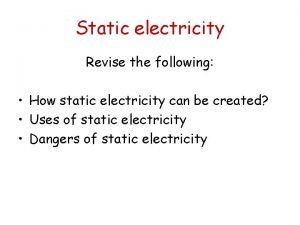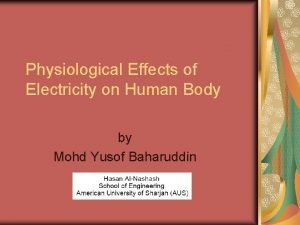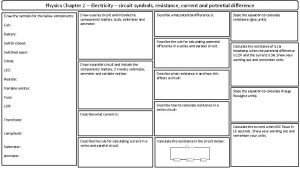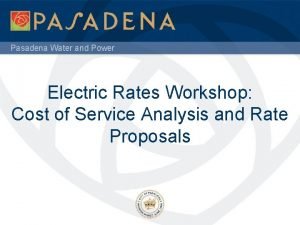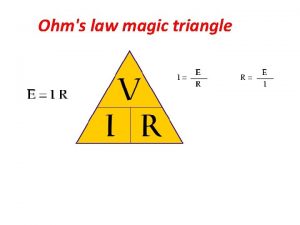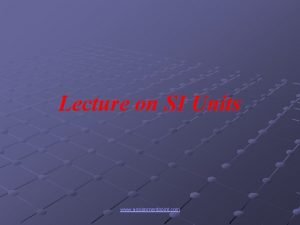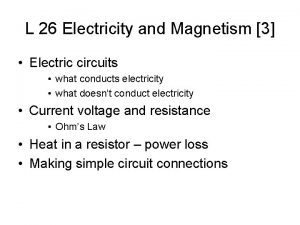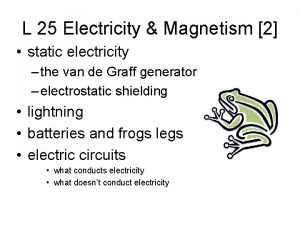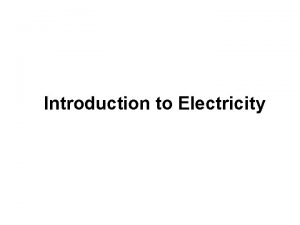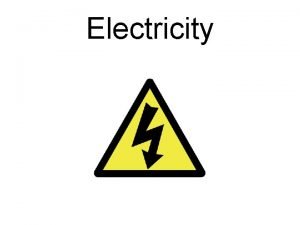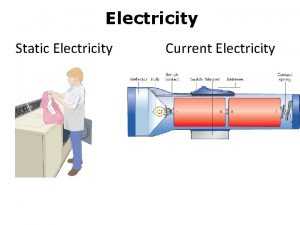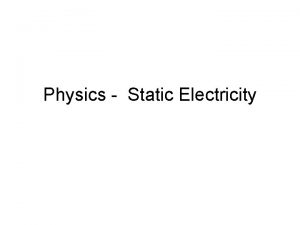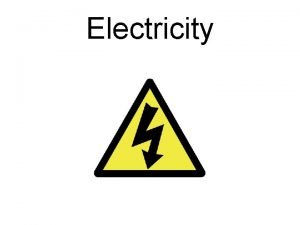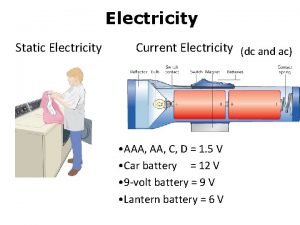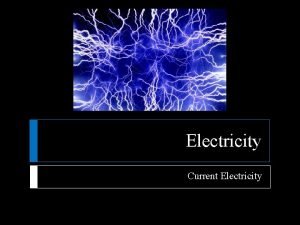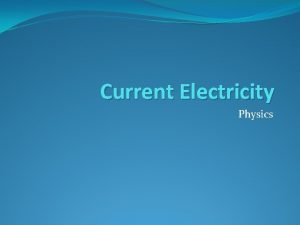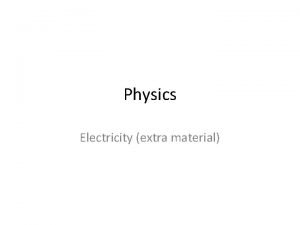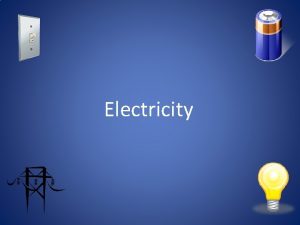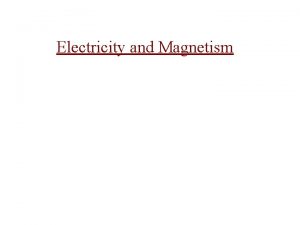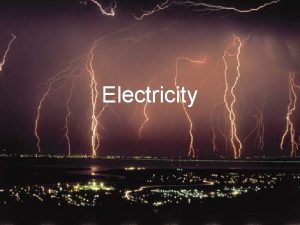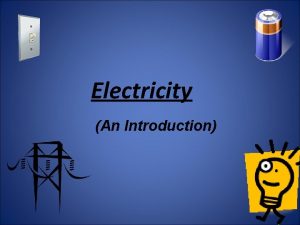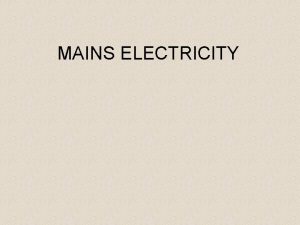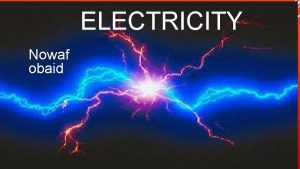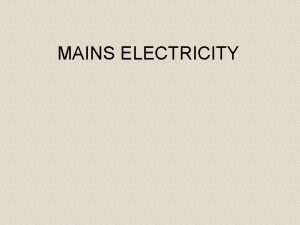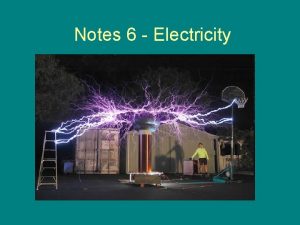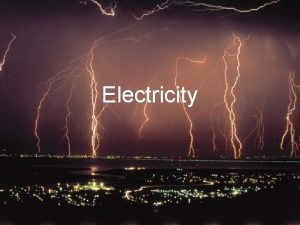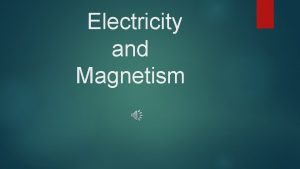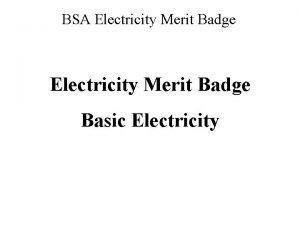Unit 10 Lesson 1 What Is Electricity Copyright





























- Slides: 29

Unit 10 Lesson 1 What Is Electricity? Copyright © Houghton Mifflin Harcourt Publishing Company

Unit 10 Lesson 1 What Is Electricity? All Charged Up • Atoms are the building blocks of matter. electron Nucleus Copyright © Houghton Mifflin Harcourt Publishing Company

Unit 10 Lesson 1 What Is Electricity? All Charged Up • Atoms are the building blocks of matter. • Atoms are so small you cannot see them with your eyes alone. They are made of smaller particles called protons, neutrons, and electrons. • Electric charge is a property of a particle that affects how it behaves around other particles. Copyright © Houghton Mifflin Harcourt Publishing Company

Unit 10 Lesson 1 What Is Electricity? All Charged Up • Protons have a positive charge (+1). • Electrons have a negative charge (– 1). • Neutrons are neutral. They have no charge. Copyright © Houghton Mifflin Harcourt Publishing Company

Unit 10 Lesson 1 What Is Electricity? All Charged Up • When an atom has equal numbers of protons and electrons, the charges cancel each other. Copyright © Houghton Mifflin Harcourt Publishing Company

Unit 10 Lesson 1 What Is Electricity? All Charged Up • Electric charge is a property of a particle that affects how it behaves around other particles. Copyright © Houghton Mifflin Harcourt Publishing Company

Unit 10 Lesson 1 What Is Electricity? All Charged Up • Atoms sometimes gain or lose electrons. Gaining or losing electrons will change the positive or negative charges of the atom. • If an atom gains electrons, it will have a negative charge. If a neutral atom loses an electron, it will have a positive charge. Copyright © Houghton Mifflin Harcourt Publishing Company

Unit 10 Lesson 1 What Is Electricity? All Charged Up Exit slip 1 Copyright © Houghton Mifflin Harcourt Publishing Company

Unit 10 Lesson 1 What Is Electricity? All Charged Up Warm up 2 Copyright © Houghton Mifflin Harcourt Publishing Company

Unit 10 Lesson 1 What Is Electricity? Opposites Attract • Particles with the same charge repel, or push away from, one another. • Particles with opposite charges attract one another, or pull together. Copyright © Houghton Mifflin Harcourt Publishing Company

Unit 10 Lesson 1 What Is Electricity? Opposites Attract • Static electricity is the buildup of electric charges on objects. • Static means “not moving. ” Copyright © Houghton Mifflin Harcourt Publishing Company

Unit 10 Lesson 1 What Is Electricity? All Charged Up Warm up 1 Copyright © Houghton Mifflin Harcourt Publishing Company

Unit 10 Lesson 1 What Is Electricity? All Charged Up Copyright © Houghton Mifflin Harcourt Publishing Company

Unit 10 Lesson 1 What Is Electricity? Opposites Attract • Why does static electricity cause your hair to stand “on end”? Copyright © Houghton Mifflin Harcourt Publishing Company

Unit 10 Lesson 1 What Is Electricity? Opposites Attract If you rub a balloon on your hair, the balloon picks up extra electrons that give it a negative charge. When you bring the balloon near a wall, electrons in a small part of the wall are repelled and move away, leaving a positive charge at the wall surface. Copyright © Houghton Mifflin Harcourt Publishing Company

Unit 10 Lesson 1 What Is Electricity? Opposites Attract In the dryer, atoms in clothing gain and lose electrons. Each piece of cloth becomes charged. The positively charged surfaces attract the negatively charged surfaces. As a result the cloths stick together. Copyright © Houghton Mifflin Harcourt Publishing Company

Unit 10 Lesson 1 What Is Electricity? Opposites Attract Exit slip 2 . Copyright © Houghton Mifflin Harcourt Publishing Company

Unit 10 Lesson 1 What Is Electricity? Opposites Attract Warm up 3 . Choose the particles that will attract Copyright © Houghton Mifflin Harcourt Publishing Company

Unit 10 Lesson 1 What Is Electricity? Lightning Strikes • Static charges stay on an object until it comes close to an object with a different charge. • An electrostatic discharge happens when electrons jump from an object with a negative charge to an object with a positive charge. Copyright © Houghton Mifflin Harcourt Publishing Company

Unit 10 Lesson 1 What Is Electricity? Lightning Strikes • Raindrops and ice particles bump into each other during a thunderstorm, causing an electric charge to build in the clouds. • Positive charges form at the top of a cloud and on the ground. Negative charges form near the bottom of the cloud. Copyright © Houghton Mifflin Harcourt Publishing Company

Unit 10 Lesson 1 What Is Electricity? Lightning Strikes • When the difference in charge between a cloud and the ground is great enough, lightning occurs. • Lightning is a huge electrostatic discharge. Copyright © Houghton Mifflin Harcourt Publishing Company

Unit 10 Lesson 1 What Is Electricity? Lightning Safety • Stay inside and turn off electrical appliances. • Stay away from windows. • If you can’t get inside, wait in a car with a metal roof. • Listen to the weather forecast for updates about thunderstorms. • Make a plan in case a thunderstorm develops. Copyright © Houghton Mifflin Harcourt Publishing Company

Unit 10 Lesson 1 What Is Electricity? Lightning Strikes Exit slip 3 Copyright © Houghton Mifflin Harcourt Publishing Company

Unit 10 Lesson 1 What Is Electricity? Lightning Strikes Warm up 4 Choose the picture that represents Static electricity Copyright © Houghton Mifflin Harcourt Publishing Company

Unit 10 Lesson 1 What Is Electricity? Current Events • When electric charges have a path to follow, they move in a steady flow called an electric current. • Chemical reactions in batteries can provide a flow of electrons. • An electricity generating station is another source of electric current. Copyright © Houghton Mifflin Harcourt Publishing Company

Unit 10 Lesson 1 What Is Electricity? Current Events • What is the purpose of the insulator on the wire shown below? Copyright © Houghton Mifflin Harcourt Publishing Company

Unit 10 Lesson 1 What Is Electricity? Current Events • Moving electric charges are more useful than static electricity. • Electrons can be made to move through a wire. They make up an electric current. You can use electric current to do many kinds of work. • Electric currents for homes, schools, and businesses come from energy stations. These stations change chemical, nuclear, or mechanical energy into electrical energy. Copyright © Houghton Mifflin Harcourt Publishing Company

Unit 10 Lesson 1 What Is Electricity? Current Events Copyright © Houghton Mifflin Harcourt Publishing Company

Unit 10 Lesson 1 What Is Electricity? Current Events Exit slip 4 Copyright © Houghton Mifflin Harcourt Publishing Company
 Static electricity and current electricity
Static electricity and current electricity Current electricity gif
Current electricity gif Magnetism vocabulary
Magnetism vocabulary Andythelwell
Andythelwell Joshuas law unit 10 lesson 1
Joshuas law unit 10 lesson 1 How to label hyp opp adj
How to label hyp opp adj Unit 6 review questions
Unit 6 review questions Physics 102 electricity and magnetism
Physics 102 electricity and magnetism Van de graaff generator diagram
Van de graaff generator diagram Unit 2 materials technology
Unit 2 materials technology Ib physics topic 5 questions and answers
Ib physics topic 5 questions and answers Bsa weather merit badge
Bsa weather merit badge Wind power pros and cons
Wind power pros and cons Particle model of electricity
Particle model of electricity Static electricity diagram
Static electricity diagram Static electricity
Static electricity Snc1d electricity
Snc1d electricity Does water conduct electricity
Does water conduct electricity Physiological effects of electricity on the human body
Physiological effects of electricity on the human body Physics circuits symbols
Physics circuits symbols Electricity and magnetism lecture notes
Electricity and magnetism lecture notes Pasadena power
Pasadena power Ohms law triangle
Ohms law triangle What is nature of electricity
What is nature of electricity How to calculate water tariffs grade 11
How to calculate water tariffs grade 11 What is missing
What is missing Physics 241 purdue
Physics 241 purdue Water conducts electricity
Water conducts electricity Salt water electricity generator
Salt water electricity generator Charge symbol and unit
Charge symbol and unit



